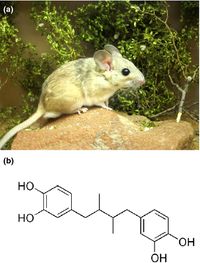Co-Evolution of Microbes and the Mammalian Gut
Introduction

By Joanna van Dyk
Microbes likely had commensal relationships with the ancestors of mammals, long before they evolved to give birth to live young or obtained many of the traits that charcterize the class of vertabrates today. [2] The digestive tract of a mammal provides a perfect environment for microbial colonization, it is moist, warm, and has a continuous supply of food. The microbes, in turn, are able to produce toxin-digesting enzymes that allow their hosts to consume a wide variety of nutrients.[3] Today, the microbiota of mammalian guts show similarities between species from similar ancestry, but also between those that have similar diets. [2] The earliest mammals were carnivorous, and without microbes, they would have not been able take advantage of the diverse array of nutrients offered by the plant kingdom. This allowed them to fill many of the ecological niches left when the dinosaurs became extinct 65 million years ago.[4] Mammalian gut microbiomes have evolved to aid their hosts in the digestion of plant toxins that would otherwise completely disable them, such as Nordihydroguaiaretic acid. This chemical would cause desert woodrats (N. lepida) to develop kidney cysts and liver damage if its gut bacteria did not digest it for them. [5] Unlike other vertebrates, mammals are in the unique position of being able to inherit their microbiomes from their mothers through the vaginal canal and through breast milk. This may enable the preservation of microbial lineages over time[6]
In this page we adress the questions: How specialized are the microbe lineages associated with mammalian guts? And, when a mammal adopts a diffferent diet, how much does its gut microbiome resemble the microbiomes of its close relatives?
Early Evolution
Colonization of the Gut

Hidgut and Foregut Fermentation

Detoxification of Plant Secondary Compounds
Unlike animals, plants cannot run away from other organisms trying to consume them. Whilst moving prey have evolved fast running legs and meticulous camoflage to evade predators, plants must rely on chemical compounds to avoid being eaten. Plant toxins are diverse, and can do anything to consumers from causing mild digestive discomfort, to triggering abortions and death [4]. These compounds are known as plant secondary metabolites (PSMs), and they have a significant impact on the nutritional ecology of mammals that eat them[3].Whilst herbivores can develop enzymes to digest toxins themselves, mammalian genomes are far slower to evolve than those of tiny, fast-replicating bacteria. Microbes are able to digest almost any compound on the planet[9], and since they evolve so quickly and can horizontally transfer genes between species, they are able to occupy any ecological niche within the mammalian gut. This may be one of the reasons that herbivorous mammals have been so successful in many earth ecosystems[4]. However, studies that specifically address the microbiome as a driver of diet diversification in herbivores have been inconclusive[10].

Detoxification of Creosete resin in Desert Woodrats
Study of the relationship between the gut microbiota in The desert woodrat (N. lepida), and the animals tolerance to PSCs on the creosete bush in the mojave desert, is well doccumented[11][10][5]. The creosete bush is abundant in the Mojave desert, in the southern United States, because of its resistance to herbivores, drought and ageing [4].
Conclusion
References
- ↑ Luo, Zhe-Xi. "Transformation and diversification in early mammal evolution." Nature 450.7172 (2007): 1011-1019.
- ↑ 2.0 2.1 Ley, Ruth E et al. “Worlds within worlds: evolution of the vertebrate gut microbiota.” Nature reviews. Microbiology vol. 6,10 (2008): 776-88. doi:10.1038/nrmicro1978
- ↑ 3.0 3.1 Dearing, M. Denise, William J. Foley, and Stuart McLean. "The influence of plant secondary metabolites on the nutritional ecology of herbivorous terrestrial vertebrates." Annual review of ecology, evolution, and systematics 36 (2005)
- ↑ 4.0 4.1 4.2 4.3 Yong, Ed. I contain multitudes: The microbes within us and a grander view of life. Random House, 2016.
- ↑ 5.0 5.1 5.2 Kohl, Kevin D., et al. "Gut microbes of mammalian herbivores facilitate intake of plant toxins." Ecology Letters 17.10 (2014): 1238-1246.
- ↑ Kelley, Scott T., and Susanne Dobler. "Comparative analysis of microbial diversity in Longitarsus flea beetles (Coleoptera: Chrysomelidae)." Genetica 139.5 (2011): 541-550.
- ↑ Stevens, C. Edward, and Ian D. Hume. "Contributions of microbes in vertebrate gastrointestinal tract to production and conservation of nutrients." Physiological reviews 78.2 (1998): 393-427.
- ↑ Grajal, A., and S. D. Strahl. "A bird with the guts to eat leaves." Natural History 8 (1991): 48.
- ↑ Leahy, Joseph G., and Rita R. Colwell. "Microbial degradation of hydrocarbons in the environment." Microbiology and Molecular Biology Reviews 54.3 (1990): 305-315
- ↑ 10.0 10.1 Kohl, Kevin D., and M. D. Dearing. "Experience matters: prior exposure to plant toxins enhances diversity of gut microbes in herbivores." Ecology letters 15.9 (2012): 1008-1015.
- ↑ Karasov, William H. "Nutritional bottleneck in a herbivore, the desert wood rat (Neotoma lepida)." Physiological Zoology 62.6 (1989): 1351-1382.
Authored for BIOL 238 Microbiology, taught by Joan Slonczewski, 2018, Kenyon College.
